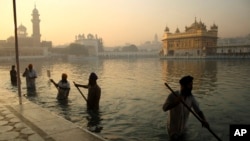The chronic air pollution blanketing much of northern India is now threatening the holiest shrine in the Sikh religion, making the once-gleaming walls of the Golden Temple dingy and dull.
There is little to be done short of replacing the 430-year-old temple's gold-plated walls — an expensive project already undertaken more than a century ago and then again in 1999.
To cut down on pollution, environmentalists and religious leaders have launched a campaign that includes persuading farmers to stop burning spent crops to clear their fields, removing industry from the area and cutting back on traffic. A community kitchen called a "langar'' that serves up to 100,000 people free meals every day at the temple is also switching from burning wood to cooking with gas.
But so far the campaign hasn't had much impact, with change happening slowly and still no pollution monitoring equipment installed.
"As far as pollution goes, we are paying attention,'' said Jaswant Singh, environmental engineer at the State Pollution Control Board, a government regulatory authority. "We are in the process of procuring equipment so that we can check the pollution area, pollution from every source on a day-to-day basis.''
Officials have also banned burning trash or cooking with certain fuels in restaurants and communities nearby, but enforcement so far remains weak. The city also wants to build an electricity station to stop people from using diesel-fueled generators, but Singh could not say when that might happen.
"The pollution degrading the Golden Temple is growing,'' said environmental activist Gunbir Singh, who heads a group called Eco Amritsar. "We need to do a hell of a lot of work to protect the holy city status of this city.''
It's unclear how much replacing the gold plating would cost, but it would surely be high.
"This is gold. The cost would be huge, but still would not be a problem,'' Gunbir Singh said, suggesting Sikh devotees would rally behind the cause if needed. "Most of the activity that goes on there is based on donations — people will take off their bangles and rings and leave them if work needs to be done.''
Thousands of Sikh devotees and tourists every day visit Amritsar, the main city in Punjab state, to see the 17th century shrine, surrounded by a moat known as the "pool of nectar,'' or "Sarovar,'' and housing the Sikh holy book, the Guru Granth Sahib. Most of the world's 27 million Sikhs, whose monotheistic religion originated in Punjab in the 15th century, live in India.
The country suffers some of the world's worst air pollution, thanks to a heavy reliance on burning coal for electricity, diesel in cars and power generators, and kerosene and cow dung for cooking and lighting homes. Heavy construction amid a decade-long economic boom has also kicked up huge clouds of dust, and farmers still regularly clear their fields with fire, sending even more black carbon into the air.
The capital of New Delhi was named by the WHO as the world's most polluted city, while Amritsar — about 390 kilometers (240 km) to the north — was ranked India's ninth most polluted.
The Golden Temple is not the only major monument to be affected by pollution. The white marbled Taj Mahal has also become dirty from pollution from the nearby city of Agra, and every few years, workers from the Archaological Survey of India place mud packs on its walls to keep them from turning yellow and brown.
But many across the country remain unaware of the risks in breathing unhealthy air, even as scientists warn it is sickening countless Indians every year. About 1.4 million Indians were killed by illnesses related to air pollution in 2013, according to a recent study by researchers at the University of British Colombia, in Vancouver.
That tally will only rise unless pollution levels are drastically curbed, experts have said. Instead, the pollution is getting worse, according to NASA satellite images revealing particulate matter in the air. An analysis last month by the environmental group Greenpeace showed the overall concentration of PM2.5 — the tiny lung-clogging particulate matter suspended in the air — increasing 13 percent from 2010 to 2015.
With pollution fast damaging the Golden Temple, some in the Sikh heartland said they were reminded of their religious duty to protect nature.
"Our holy book teaches us that the air is the teacher, the water is the father and the earth is the mother. So we have to be mindful of all the elements of nature as true Sikhs,'' the environmentalist Gunbir Singh said.
Authorities plan to ban vehicles from the area immediately surrounding the shrine. "Even the devotees will have to come on foot,'' said Harcharan Singh, who heads the Shrimoni Gurudwara Prabhandak Committee, which oversees the six major Sikh temples across India.
But efforts have been slow, and officials admit so far incomplete.
Sikh preacher Baba Sewa Singh said he and his devotees have tried to help mitigate the pollution threat by planting more than 100,000 trees in the region.
"If anyone asks about the saplings,'' he said, "we plant then for free in their villages.''
India's Once-Gleaming Golden Temple Dulled by Air Pollution

AMRITSAR, INDIA —








